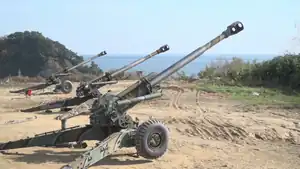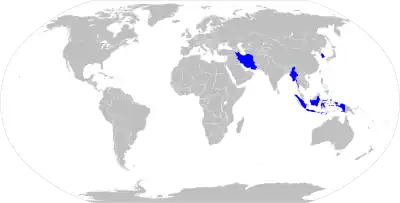KH179
The KH179 ("Korean Howitzer 1 (First) 79") is a South Korean 155 mm 39 caliber towed howitzer designed and developed by the Agency for Defense Development (ADD) for the Republic of Korea Armed Forces, and is now manufactured by Hyundai WIA.[2][3]
| KH179 155 mm Towed Howitzer | |
|---|---|
 KH179 155mm howitzer | |
| Type | Towed howitzer |
| Place of origin | South Korea |
| Service history | |
| In service | 1983–present |
| Used by | See Operators |
| Wars | Iran–Iraq War |
| Production history | |
| Designer | Agency for Defense Development |
| Designed | 1979–1982 |
| Manufacturer | Kia Machine Tool (1983–1996) Kia Heavy Industry (1996–2001) WIA (2001–2009) Hyundai WIA (2009–present) |
| Unit cost | ₩120 million (2017) |
| Produced | 1983–present |
| Specifications | |
| Mass | 6,890 kg (15,190 lb)[1] |
| Length | Travel: 10.389 m (30 ft) |
| Barrel length | 7.08 m (23 ft 3 in) |
| Width | Travel: 2.44 m (8 ft) |
| Height | Travel: 2.36 m (7 ft 9 in) |
| Crew | 10 |
| Caliber | 155 mm (6.1 in) |
| Breech | Interrupted screw |
| Recoil | Variable, hydropneumatic, independent[2] |
| Elevation | 1,220 mils[2] |
| Traverse | ±448 mils[2] |
| Rate of fire | 4 rds/min (maximum) 2 rds/min (sustain)[2] |
| Muzzle velocity | 913 m/s (3,000 ft/s) |
| Maximum firing range | 17.7 km (K305, DP-ICM) 18 km (M107, HE) 28 km (K310, BB/DP-ICM) 30 km (M549A1, HE-RAP) |
Development
The KH179 is a towed Howitzer developed and produced by Kia Precision Industry (now Hyundai WIA) since 1983 for the purpose of replacing the U.S. M114A2 towed Howitzer and enhancing artillery firepower.
General characteristics
The KH179 makes use of lightweight components (CN79 barrel, RM79 recoil buffer, and CG79 mount) and can be air-transported by CH-47 chinook helicopter and C-130 transport aircraft. In addition, performance improvements were made in range, reliability, and maintenance compared to conventional M114A2 howitzers operated by the South Korean military. The ammunition used in the KH179 is compatible with NATO 155 mm standard ammunition, but has significantly improved range and firepower.
It is equipped with a direct/indirect aiming mirror, allowing both direct and indirect howitzer firing. Direct fire uses an L-type aiming mirror with 3.5 magnification and has an effective range of 1,500 m. Indirect shooting uses a four-magnification panoramic aim mirror mounted on the left. The range is 18.1 km for normal rounds, 30 km for rocket-assisted rounds, and the firing rate is 2 rounds per minute for continuous shots, and the maximum firing rate is 4 rounds per minute.
Operational history
Operators

Current operators
 Indonesia : 18 for the Indonesian Army, purchased in 2011.[4] Stationed in three batteries in Borneo Island (2), near Malaysian border (2) and one on Sumatra Island.[4]
Indonesia : 18 for the Indonesian Army, purchased in 2011.[4] Stationed in three batteries in Borneo Island (2), near Malaysian border (2) and one on Sumatra Island.[4] Iran : Unknown quantity purchased during Iran–Iraq War.[3][5][6] Later copied and produced locally as HM-41.
Iran : Unknown quantity purchased during Iran–Iraq War.[3][5][6] Later copied and produced locally as HM-41. Myanmar : More than 100 in service with the Myanmar Army.[7]
Myanmar : More than 100 in service with the Myanmar Army.[7] South Korea : 1,000 in service with the Republic of Korea Army and the Republic of Korea Marine Corps.[3]
South Korea : 1,000 in service with the Republic of Korea Army and the Republic of Korea Marine Corps.[3]
See also
- AH4 howitzer – Chinese 155 mm towed artillery
- HM-41 – Iranian 155 mm towed howitzer
- M777 howitzer – British/American 155 mm towed artillery
References
- "Defense Business". Hyundai WIA. Archived from the original on 30 April 2022. Retrieved 30 April 2022.
- "Gun & Artillery System" (PDF). Hyundai WIA. Archived from the original (PDF) on 14 October 2021. Retrieved 14 October 2021.
- [첨단국가의 초석, 방위산업] 자주국방의 포문을 열다 - KH-179 개발사, retrieved 2021-12-23
- "Indonesian Army to train for the first time with its KH-179 155mm howitzer". Army Recognition. 18 March 2015. Archived from the original on 28 May 2022. Retrieved 28 May 2022.
- Kim Gwanyong (26 March 2017). "[e-무기]화포 개발의 '독립선언', 국산 견인곡사포 KH-179". Edaily. Archived from the original on 30 April 2022. Retrieved 30 April 2022.
- Kim Hangyeong (14 May 2018). "[한국무기 디테일] ⑥ 사거리 30km인 한국형 155mm 견인곡사포, 기아기공(현 현대 위아)의 KH179". Security Fact. Archived from the original on 30 April 2022. Retrieved 30 April 2022.
- "Myanmar". Asia Pacific Defence Reporter. 2010. Archived from the original on 29 November 2014. Retrieved 29 November 2014.